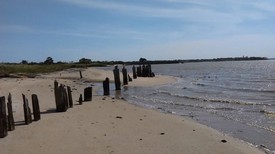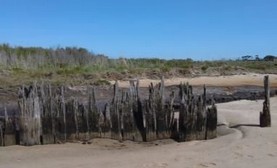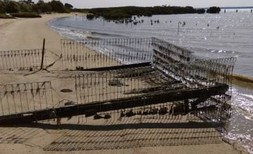Queensferry the town that vanished
Published by Noelene Lyons in lost town vanished · Thursday 15 Oct 2015
Tags: queensferry, vanaished, lost, town
Tags: queensferry, vanaished, lost, town
Queensferry The South Gippsland Town that vanished.
 Queensferry was one of our Pioneer towns that grew, flourished and then disappeared. As you drive up the Bass Highway towards Cranbourne, just a few kilometres before you come to Maru Park on the LHS you might see the 101 km post which once had a hotel on each corner....this is now called Queensferry Jetty Road. In 1881 Lyson Howell Williams built the large Victorian Hotel on the western corner and the district took the name of the hotel. If you travel along
Queensferry was one of our Pioneer towns that grew, flourished and then disappeared. As you drive up the Bass Highway towards Cranbourne, just a few kilometres before you come to Maru Park on the LHS you might see the 101 km post which once had a hotel on each corner....this is now called Queensferry Jetty Road. In 1881 Lyson Howell Williams built the large Victorian Hotel on the western corner and the district took the name of the hotel. If you travel along  Queensferry Jetty Road to the shore, the remains of a sizable jetty will help you imagine the thriving town
Queensferry Jetty Road to the shore, the remains of a sizable jetty will help you imagine the thriving townwhich once stood here. The town developed around the jetty which was another shipping port linking Western Gippsland with Melbourne. Small ships carried either passengers or cargo to and from ports such as Queensferry and Grantville to the western side of Westernport or Melbourne. Road travel in the late 1880s was very difficult and often impassable, particularly around the Koo Wee Rup swamp areas. It was proven much cheaper and easier to travel via the sea. So if you go for a visit to see the Queensferry Town that disappeared. Look for the sign “Queensferry Jetty Road” Stand at the beach with your back to the water and imagine a settlement by the sea with hotels, Colonial Wine Saloon, 3 Public Halls, a General Store and small and large houses that would have been there a century ago. Paddocks of hearth stones and weather beaten pear trees which marks the spot of Mr. George McGowan’s large two storey residence on the road called Esplanade. Large extravagant parties were held at his residence and were very well attended. At one of his parties his house caught fire and was totally destroyed. Mr McGowan built a small cottage and lived there for the remainder of his days. The decline of the Queensferry settlement began when the railway line was built across the Koo Wee Rup Swamp and along the Bass Valley. The port ceased to be the centre of commerce and people moved away. The town continued but at a much reduced population, then in the late 1920’s the final episode in the demise of Queensferry drove out the last six residents.  It was the rise of the abnormal height tide,which flooded into houses and inundated most of Queensferry. The flood was not serious but it saturated the land with saltwater rendering it useless for many years.Today white mangrove can be seen growing in the soft black mud along the shores.Insect eating birds together with Spoonbillsand Herons feed on the mud flats. Returning from Queensferry Jetty Road youwill pass an artesian bore. The artesian water was discovered while drilling for coal.It was reported that when it was struck, the force of the water blew the machinery off the top of the bore. Coal has never been mined there, but the water flowed for many years. The water was used by Cobb & Co Coaches on their trips
It was the rise of the abnormal height tide,which flooded into houses and inundated most of Queensferry. The flood was not serious but it saturated the land with saltwater rendering it useless for many years.Today white mangrove can be seen growing in the soft black mud along the shores.Insect eating birds together with Spoonbillsand Herons feed on the mud flats. Returning from Queensferry Jetty Road youwill pass an artesian bore. The artesian water was discovered while drilling for coal.It was reported that when it was struck, the force of the water blew the machinery off the top of the bore. Coal has never been mined there, but the water flowed for many years. The water was used by Cobb & Co Coaches on their trips
 It was the rise of the abnormal height tide,which flooded into houses and inundated most of Queensferry. The flood was not serious but it saturated the land with saltwater rendering it useless for many years.Today white mangrove can be seen growing in the soft black mud along the shores.Insect eating birds together with Spoonbillsand Herons feed on the mud flats. Returning from Queensferry Jetty Road youwill pass an artesian bore. The artesian water was discovered while drilling for coal.It was reported that when it was struck, the force of the water blew the machinery off the top of the bore. Coal has never been mined there, but the water flowed for many years. The water was used by Cobb & Co Coaches on their trips
It was the rise of the abnormal height tide,which flooded into houses and inundated most of Queensferry. The flood was not serious but it saturated the land with saltwater rendering it useless for many years.Today white mangrove can be seen growing in the soft black mud along the shores.Insect eating birds together with Spoonbillsand Herons feed on the mud flats. Returning from Queensferry Jetty Road youwill pass an artesian bore. The artesian water was discovered while drilling for coal.It was reported that when it was struck, the force of the water blew the machinery off the top of the bore. Coal has never been mined there, but the water flowed for many years. The water was used by Cobb & Co Coaches on their trips